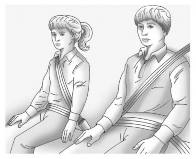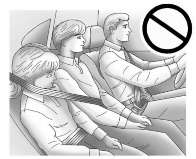< Previous | Contents | Next >
![]()
Airbag System Check
The airbag system does not need
regularly scheduled maintenance or replacement. Make sure the airbag

readiness light is working. See Airbag Readiness Light 0 139.
Caution
If an airbag covering is damaged, opened, or broken, the airbag may not work properly. Do not open or
break the airbag coverings. If there are any opened or broken airbag
coverings, have the airbag covering and/or airbag module replaced. For the location of the airbags, see
Where Are the Airbags? 0 86. See
your dealer for service.
Replacing Airbag System Parts after a Crash

{ Warning
A crash can damage the airbag
systems in the vehicle. A damaged airbag system may not properly
protect you and your passenger(s) in a crash, resulting in serious
injury or even death. To help make sure the airbag systems are working properly after a crash, have them
inspected and any necessary
replacements made as soon as possible.
If an airbag inflates, you will need to replace airbag system parts. See your dealer for service.
If the airbag readiness light stays on after the vehicle is started or comes on when you are driving, the airbag system may not work properly. Have the vehicle serviced right away. See Airbag Readiness Light 0 139.
![]()
Child Restraints
Older Children

Older children who have outgrown
booster seats should wear the vehicle’s
seat belts.
SEATS AND RESTRAINTS 97
![]()
The manufacturer instructions that
come with the booster seat state the weight and height limitations for that booster. Use a booster seat with a
lap-shoulder belt until the child passes the fit test below:
. Sit all the way back on the seat.
Do the knees bend at the seat
edge? If yes, continue. If no, return to the booster seat.
. Buckle the lap-shoulder belt. Does the shoulder belt rest on the
shoulder? If yes, continue. If no, try using the rear seat belt
comfort guide, if available. See
“Rear Seat Belt Comfort Guides” under Lap-Shoulder Belt 0 80. If a
comfort guide is not available, or if the shoulder belt still does not rest on the shoulder, then return to the booster seat.
. Does the lap belt fit low and snug on the hips, touching the thighs?
If yes, continue. If no, return to the booster seat.
. Can proper seat belt fit be
maintained for the length of the
trip? If yes, continue. If no, return to the booster seat.
![]()
additional restraint a shoulder belt can provide. The shoulder belt
should not cross the face or neck.
The lap belt should fit snugly
below the hips, just touching the
top of the thighs. This applies belt force to the child's pelvic bones in a crash. It should never be worn
over the abdomen, which could
cause severe or even fatal internal injuries in a crash.
Also see “Rear Seat Belt Comfort
Guides” under Lap-Shoulder Belt 0 80.
According to accident statistics, children are safer when properly
restrained in a rear seating position.
In a crash, children who are not
buckled up can strike other people
who are buckled up, or can be thrown out of the vehicle. Older children need to use seat belts properly.
![]()

{ Warning
Never allow more than one child to wear the same seat belt. The seat
belt cannot properly spread the
impact forces. In a crash, they can be crushed together and seriously

injured. A seat belt must be used by only one person at a time.